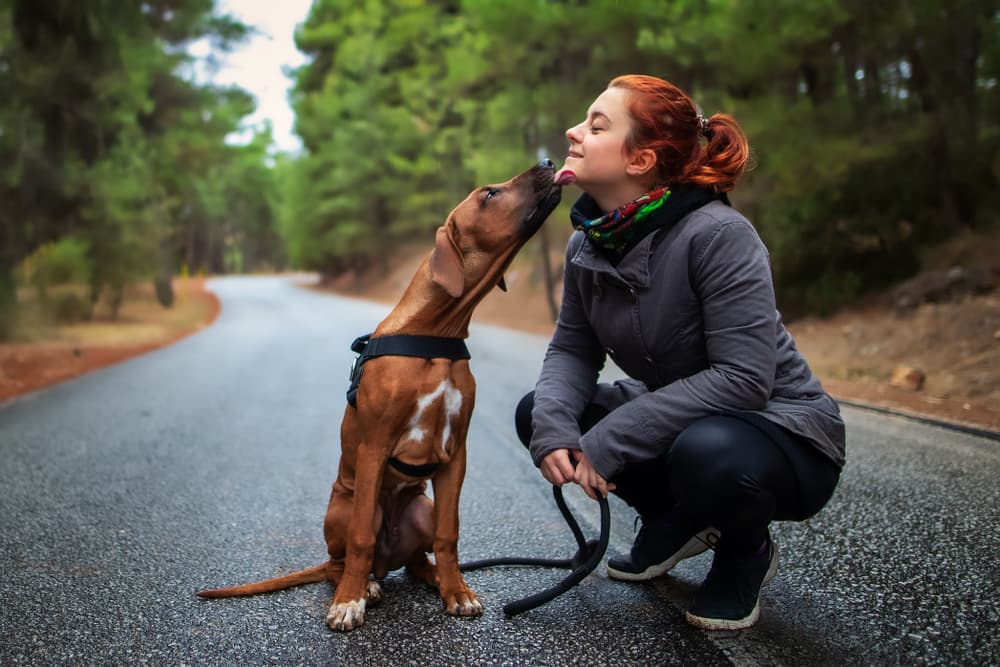Best Dog Allergy Tests At Home: 5 Options To Consider
by Carol Bryant
Updated on December 16, 2024

Of the top 10 reasons dog parents take their dog to the veterinarian, skin conditions are in the top three. Dog allergies can manifest in many ways, including skin infections, hot spots, yeast infections, or dandruff. Fortunately, dog allergy tests at home are a convenient option for pet parents looking for a convenient way to help their pups.
What starts as itching and scratching can quickly escalate into infection, discomfort, and costly medical bills. Like people, dogs develop allergies and sensitivities to a variety of environmental and food-based reasons. According to a report published by Banfield Pet Hospital, dog allergies are always in season.
Allergens can vary by a pet parent’s climate and region, but many common triggers are found in the home where your dog resides. Common triggers include:
- Dust and storage mites
- Food
- Pollen
- Dander
- Fleas
- Molds
- Fabrics
- Feathers
- Medications
- Cleaning solutions
The good news is there’s a diverse range of dog allergy tests available on the market these days. These at-home tests are designed to pinpoint the potential triggers of your pet’s symptoms.
Within this article, you’ll learn which dog allergy tests are best, how they work, and the difference between a dog allergy and a dog intolerance or sensitivity.
Best Dog Allergy Tests At Home: Our Top Picks
All featured products are chosen at the discretion of the Vetstreet editorial team and do not reflect a direct endorsement by the author. However, Vetstreet may make a small affiliate commission if you click through and make a purchase.
- Overall Best Dog Allergy Test At Home: 5Strands
- Best Dog At Home Allergy Test for Food Allergies: My Pet Health Store
- Best Veterinarian-Developed Home Antibody Test: NutriScan
- Best At-Home Dog Allergy Test with Consultation Option: Glacier Peak Holistics
- Best Dog Home Allergy Test Using ELISA Method: DNA My Dog Allergy Test
5 Best Dog Allergy Tests At Home
When you’re ready to test your dog for allergies, intolerances, or sensitivities to foods or environmental factors, here are our favorites to consider.
Best Overall Dog Allergy Test at Home
Our pick: 5Strands

Pet parents who wish to focus sensitivity testing solely on food intolerances should consider the 5Strands Pet Food Intolerance Test. Each kit tests for over 275 commercial pet food ingredients from your dog’s hair sample. Some of the things tested include proteins, grains, food dyes, dairy, fruits, additives, and probiotics. Results are sent to you via email.
According to the company, following their analysis as a guideline, pets should start feeling better within 60 to 90 days. The easy-to-understand report is designed with the colors of a stop light. For example, a green dot by a food item means mild intolerance, while red indicates severe intolerance. 5Strands touts their technology as holistic to get to the “root cause of any dietary discomforts.”
Highlights
- No saliva sample required; instead collect 10 to 15 strands of your pet’s hair as the sample
- 5Strands guarantees results within seven days of receiving your sample
- Over 274 unique pet food ingredients are tested
- Testing is available on both dogs and cats
- Pets do not need to stop any allergy medication prior to testing
Things to Consider
- 5Strands offers nearly one dozen different tests for a variety of pet issues
- Multiple tests may be costly for some budgets
- 5Strands does not claim to nor test for true allergic reactions
- 5Strands testing is bioresonance, which tests for intolerances or temporary imbalances
Best Dog At Home Allergy Test for Food Allergies
Our pick: My Pet Health Store
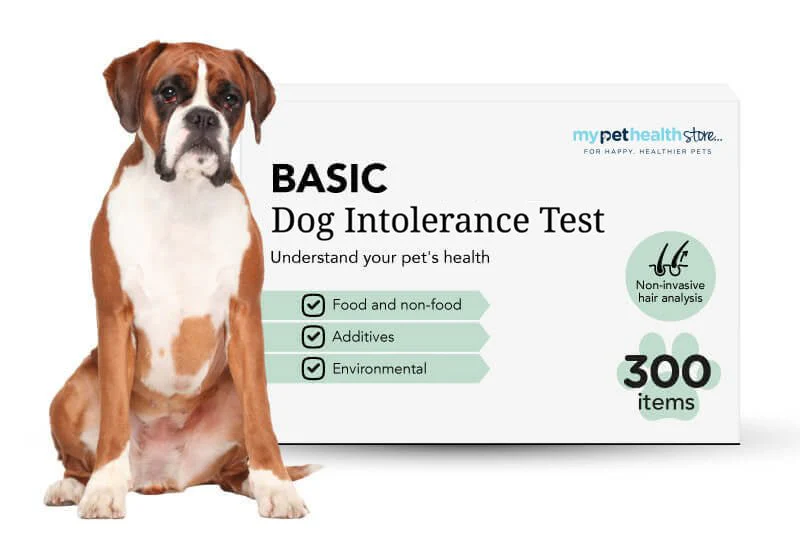
My Pet Sensitivity gives pet parents the opportunity to learn if their dog is sensitive to 300 commercial pet food ingredients. This includes things like meats, vegetables, seafood, preservatives, grains, additives, and more. Once receiving your kit, you’ll register it online using a unique reference code. The only task you perform is clipping 5 to 10 strands of your pet’s fur as close to the root as possible. Mail the hairs to the company and all future communication takes place through email.
We received a 32-page PDF sent via email outlining our Cocker Spaniel’s sensitivity results. These included foods, additives, environmental, nutrition, metals, and mineral sensitivities. You’ll also receive the next steps, a possible elimination diet, and potential meat sources to try. What’s really nice about My Pet Sensitivity results is the attention to detail with a breakdown by category.
Highlights
- The test is very easy to perform and does not require a saliva sample
- The turnaround time is three to five days once the lab has a chance to review your sample
- All communication takes place through email, thus eliminating the wait time with snail mail
- The final report is incredibly detailed with actionable steps pet parents can consider
- Any additional questions can be answered via the My Pet Sensitivity team
- Overall positive reviews from satisfied pet parents on Trustpilot
- Also available in advanced pet sensitivity testing, basic cat sensitivity testing, and basic puppy and kitten sensitivity tests.
Things to Consider
- Some pet parents claimed it took longer than 3 to 5 days to receive the results
- This test focuses on sensitivities and not allergies
- It is best to consult with your veterinarian for further questions or comprehensive allergy testing
Best Veterinarian-Developed Antibody Test
Our pick: NutriScan
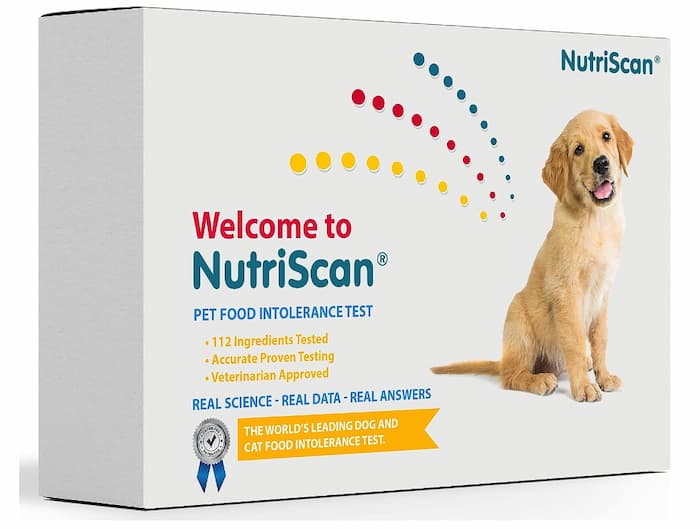
This patent-protected test was developed by renowned veterinarian Dr. Jean Dodds. The salivary-based food sensitivity and intolerance test is touted as an alternative to food trials, serum-based food allergy testing, and skin patch testing. It does not test for true food allergies, but it measures antibodies to 24 primary foods and a total of 112 related food ingredients in your dog or cat’s saliva.
NutriScan’s saliva test may reveal pre-clinical issues before they actually appear in your pet. The test can be easily performed at home or in conjunction with your veterinarian. Unlike hair tests, this saliva test measures two types of antibodies. Pet parents receive a complete summary with results within a few weeks of the lab receiving the sample.
Highlights
- Developed by Dr. Jean Dodds, who has spent more than five decades as a clinical research veterinarian
- NutriScan was developed in 2011, making it one of the longest-running tests on our list
- Measures IgA and IgM antibodies on the bowel’s mucosal surface, which correlates more to symptoms of bowel or gastrointestinal disease
- HemoPet, NutriScan’s parent company, completed two double double-blind clinical studies to validate the NutriScan test.
- Pet parents receive a complete report of ingredients to which their pet is reactive and how weak or strong each reaction is
Things to Consider
- It may be a bit tricky to get 0.5 mL of saliva from your dog
- The test should be repeated every 12 to 18 months in healthy pets, and every 4 to 6 months in food-reactive pets.
- This test is on the costly side
- Pets should not eat for at least eight hours prior to testing
Best At-Home Dog Allergy Test with Consultation Option
Our pick: Glacier Peak Holistics
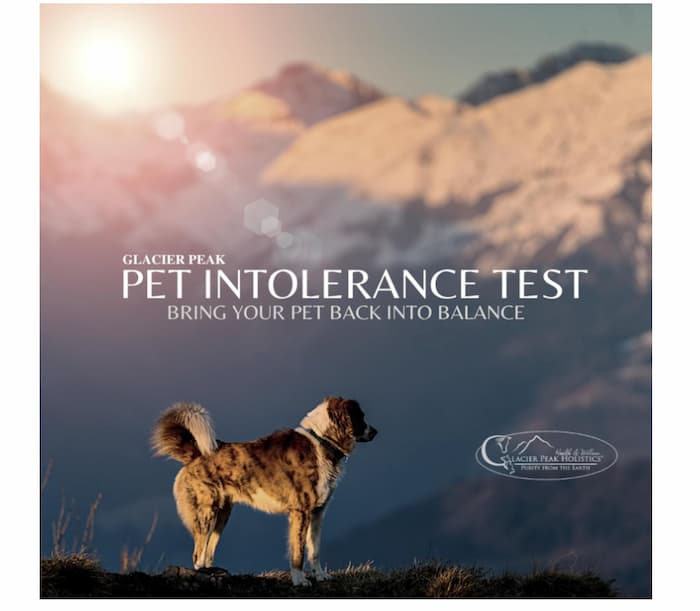
Glacier Peak Holistics offers a cheek swab/hair sample test for overall pet wellness. Like the other tests on our list, pet parents mail the samples to the company using the form and pre-paid box provided. Within two weeks in the United States, the results are sent to your email.
In addition to dietary testing, Glacier Peak’s process includes over 300 common and uncommon environmental stressors for dogs and cats like insects, grasses, pollens, and chemicals. They use an energetic analysis with an SCIO (Scientific Consciousness Interface Operations System) biofeedback device. It is touted as a non-invasive therapeutic device that combines bioresonance and biofeedback fields for energy balance and body analysis.
Highlights
- Within a few weeks, pet parents receive a detailed analysis featuring energetic imbalances and recommended Glacier Peak products
- The final report includes items your pet should avoid
- Customer service is very helpful with any questions
- Not considered to be an allergy test, but rather a life stress wellness scan using hair and saliva samples
- Phone consultation is included as part of the kit purchase
Things to Consider
- Glacier Peak’s testing is not scientifically proven
- Pet parents are offered a consultation and Glacier Peak products to consider in the report
Best Dog Home Allergy Test Using ELISA Method
Our pick: DNA My Dog Allergy Test
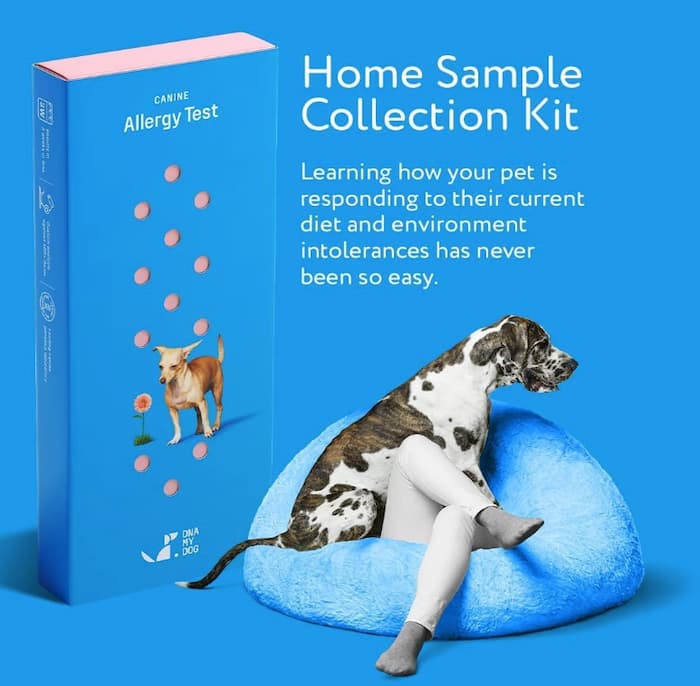
Using an oral sample, DNA My Dog Allergy uses an enzyme-linked immunosorbent assay (ELISA) method to measure your dog’s sensitivity to over 100 allergens. These include food, environmental, and household-based things. After swabbing your dog’s cheek for a saliva sample with the provided kit, pet parents send the sample in and receive results within two to three weeks.
The results feature a detailed analysis outlining items your dog has a strong intolerance to plus a care guide with actionable tips. Your report also includes items your dog did not react to. The company was formed in 2008 with a canine DNA test. The cost of the kit is reasonable and is touted as an “alternative to expensive testing and harmful medication.”
Highlights
- Easy-to-follow process and pre-labeled envelope is provided
- Some pet parents complained of a longer wait time than 2 to 3 weeks
- One of the only companies that uses the ELISA technique for antibody detection
- Company also offers a DNA test for separate purchase price
- In addition to testing for glycoproteins, the sample is also tested for hormones, proteins, and other measurements of allergy sensitivity
Things to Consider
- Process may take some time
- A saliva sample is required
How At Home Dog Allergy Tests Work
After purchasing your dog allergy test kit, you’ll receive a box with everything you need to test your dog. Home allergy tests use your dog’s hair or fur samples or a saliva sample.
Once you’ve collected the sample, you mail it back to the company in a provided envelope or container. Within a few weeks, which varies by company, you receive results via email and/or snail mail.
The kits are not intended to replace a veterinary visit or allergy testing performed by your veterinarian. However, they can be incredibly helpful to get to the bottom of your dog’s symptoms.
What Can Dogs Be Allergic To (Causes)?
There are a whole host of things your dog could be allergic to. These include:
- Flea allergies: Caused by flea bites
- Dog food allergies: Could be one ingredient or multiple ingredients
- Environmental allergies: Pollens, molds, dust, mites
- Seasonal allergies: Things that pop up during particular seasons
- Human food allergies: Dietary and skin issues from eating ‘people’ food
- Contact allergies: Things that irritate the skin, such as detergents, shampoos, chemicals, fabrics
- Medication allergies: Whether to human medications, prescription drugs, or over-the-counter products, dogs can have mild to severe reactions.
Dogs can also be allergic to things that touch their skin, such as carpet fibers, flea and tick repellants or treatments, laundry detergent or fabric softener, and plants.
Dog Allergy, Sensitivity, or Intolerance
There are so many terms being used interchangeably or in the wrong context. Dr. Jean Dodds, founder of HemoPet and NutriScan, states, “Confusing food allergies with food sensitivities (or intolerance) is a common mistake, not only among dog guardians, but also among veterinary professionals.”
Food allergies in dogs are more immediate according to Dodds. Signs include rashes, hives, swollen hives, and sometimes life-threatening reactions. She likens food allergies to the anaphylactic shock some people get when they eat peanuts.
A food sensitivity or intolerance is a chronic condition that builds up with time. Common signs of food sensitivity include gastrointestinal issues, chronic itchy or scratching of the skin, chronic burping or gassiness, or chronic skin/ear/paw infections, especially with yeast.
How To Tell If Your Dog Has Allergies
Coping with a dog who is uncomfortable can be very frustrating for you and your pooch. Constantly itching or chewing themselves can lead to infections, sores, and bigger problems.
Some of the more common signs your dog has an allergy, intolerance, or sensitivity to one or more things include, but are not limited to:
- Itching
- Scratching
- Sores or hives on the skin
- Hot spots
- Sneezing
- Ongoing ear infections
- Licking incessantly
- Biting or chewing their paws
- Diarrhea
- Vomiting
- Watery, itchy eyes
- Scooting
People have many of the same symptoms when it comes to allergies. According to the Veterinary Information Network, while people with allergies may sneeze or have asthma, dogs tend not to exhibit those symptoms. Instead, they will have red and itchy skin, hair loss, and recurring skin or ear infections.
How We Chose Our Best Dog Allergy Tests
In order to select the very best allergy tests for dogs to use at hone, we focused on these aspects:
Ratings/reviews. We want to ensure a broad range of reviews are given for each of our dog allergy tests. We looked closely at pet parent reviews and what they liked and disliked.
Number of allergens tested. Making sure your dog is tested for more than a few allergens is very important. No one wants to repeat a test or have to purchase multiple tests to get a true picture of their dog’s immune response to allergens. We included a variety of options that offer food, environmental, and other allergens tested.
Reputation. We examined each of the brands included on our list. We dove in to find out how long they’ve been in business, what is said about them on social media, and who endorses them.
Ease of use. Convenience is key when it comes to testing your dog for allergies at home. No one has time to chase their dog around, wait, hope they get a good sample, and then have to try again. There’s something for everyone on this list, and all of the tests can be performed from the comfort of home.
Dog Allergy Test Sample Tips
When attempting to get a saliva sample that requires more than a swab, here are some tried and true ways to make it happen:
- Make sure your dog has not eaten before collecting the saliva. Read the package instructions closely because some kits require your dog not to eat for at least eight hours before collection.
- Hold a tempting piece of food or treat in front of your dog but don’t give it to them. Get it close to their nose so they can smell it, and this will induce drooling or salivating.
- Don’t contaminate the sample by touching it with your fingers or allowing it to get close to other pets in the household.
- Follow the packing and mailing instructions closely for the most accurate results.
Dog Allergy Kits At Home FAQs
No. At-home allergy kits involve saliva and/or hair samples. In-office veterinary testing is performed in a clinical setting. Tests in-office involve intradermal skin testing and/or blood tests. In-office allergy tests on dogs are more comprehensive.
Many satisfied pet parents attest to their satisfaction with at-home allergy test kits for their dogs. The accuracy of an allergy test is often measured in terms of sensitivity. If you suspect your dog has allergies, starting by talking to your veterinarian is best.
Yes, any time your dog has an at-home allergy test performed, you should provide your veterinarian with a copy to discuss the results. Allergic reactions may also be due to another condition, which your dog’s medical team can investigate.
Some pet intolerance tests and allergy tests for dogs have specific age restrictions, limits, or recommendations. Always follow the manufacturer’s instructions.





